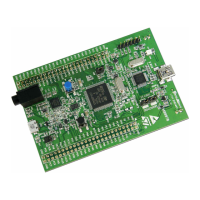The STM32 Cortex-M4 instruction set PM0214
156/262 PM0214 Rev 9
3.10.6 VCVTB, VCVTT
Converts between a half-precision value and a single-precision value.
Syntax
VCVT{y}{cond}.F32.F16 Sd, Sm
VCVT{y}{cond}.F16.F32 Sd, Sm
Where:
• ‘y’ Specifies which half of the operand register Sm or destination register Sd is used for
the operand or destination:
If y is B, then the bottom half, bits [15:0], of Sm or Sd is used.
If y is T, then the top half, bits [31:16], of Sm or Sd is used.
• ‘cond’ is an optional condition code, see Conditional execution on page 65.
• ‘Sd’ is the destination register
• ‘Sm’ is the operand register.
Operation
This instruction with the .F16.32 suffix:
1. Converts the half-precision value in the top or bottom half of a single-precision. register
to single-precision.
2. Writes the result to a single-precision register.
This instruction with the .F32.F16 suffix:
1. Converts the value in a single-precision register to half-precision.
2. Writes the result into the top or bottom half of a single-precision register, preserving the
other half of the target register.
Restrictions
There are no restrictions.
Condition flags
These instructions do not change the flags.

